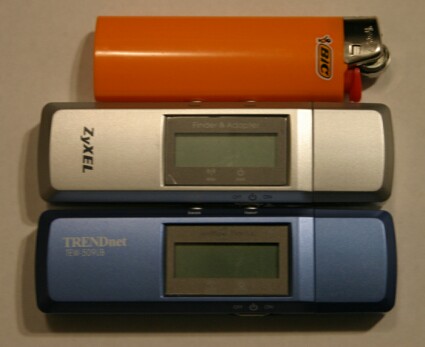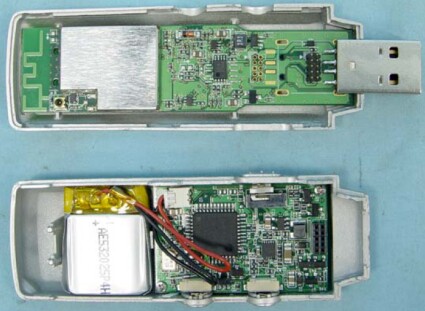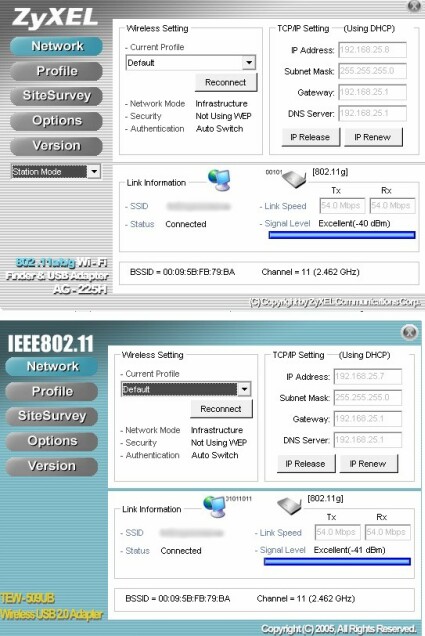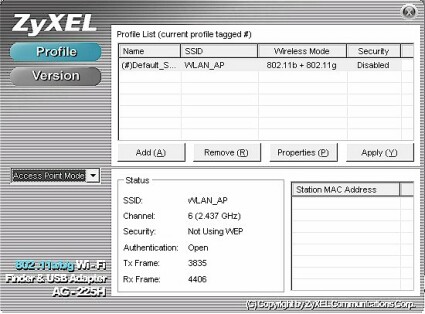Introduction

| ZyXEL AG-225H | |
|---|---|
| Pros | Cons |
| • Dual-band • Rechargeable battery • Shows SSID, encryption, signal strength • Comes with Funk Odyssey client • Functions as soft AP |
• Slightly more expensive • No backlight |
| TRENDnet TEW-509UB | |
|---|---|
| Pros | Cons |
| • Dual-band • Rechargeable battery • Shows SSID, encryption, signal strength • Slightly less expensive |
• No backlight • No AP mode or bundled Odyssey client |
In today’s world, wireless networks are nearly ubiquitous. Wherever you go, there they are – from an access point in a wireless café, to a university-wide wireless network, to even your own next-door neighbor’s access point. The only hard part is figuring out where they are and which one to connect to.
To save you the trouble of pulling out your laptop and opening up your favorite wardriving program, ZyXEL and TRENDnet have each released own finger-sized Wi-Fi finders – the AG-225H from ZyXEL and the TEW-509UB from TRENDnet – that provide all the information you need to know about in-range wireless networks. Both are the first Wi-Fi finders that are able to sniff out nearby 802.11a wireless networks, in addition to the 802.11b/g detection provided by their predecessors. In addition, both devices can act as wireless network adapters when plugged into a USB port, allowing you to connect to the WLANs that you find.
It’s obvious from looking at them, that these two products are virtually identical. The TRENDnet device may be blue and say ‘Hotspot Detector’ upon booting up, while the ZyXEL is silver and has ‘Hotspot Finder’ as its welcome message. But aside from that, the devices are like the proverbial Romulus and Remus of the Wi-Fi detector world.
A little detective work on the FCC ID website reveals that the two products use the same hardware – the WUB-410Z made by U-Media Communications in Taiwan. The U-Media website isn’t very informative, but the FCC docs show that the devices are based on ZyDAS’ ZD1211, which is an integrated baseband processor and MAC for 802.11a/b/g WLAN applications that has both USB 2.0 and 16 bit Interfaces.
Internals

Figure 1: Internal view
Figure 1 shows there are two boards packed inside that are joined by a small 10 pin connector located near the USB connector. The board in the top half of Figure 1 is the radio board (which has the ZD1211 on the other side) and the board in the bottom that is attached to the NiMH battery is most likely the processor board.
By the way, according to the FCC docs, TRENDnet’s TEW-429UB 11b/g only Wi-Fi finder / USB adapter is also manufactured by U-Media. And while I can’t say for sure that U-Media also makes Linksys’ just-announced WUSBF54G Wireless-G USB Adapter with Wi-Fi Finder, it is also based on the ZD1211 and has a design very-similar to that of the U-Media-manufactured devices.
Each device is about the size of a stick of gum (or, to use the current parlance, an iPod Shuffle), and has an on/off switch on the bottom. A cap on the front pops off to reveal the USB 2.0 connector, while there is a tiny hole on the back to allow it to be attached to a lanyard. On the top are two buttons – a ‘Seek’ button to search for wireless networks and to change the search mode, and a ‘Next’ button to view the next network in the list – and on the front is an LCD screen showing information about the currently-selected wireless network.
One problem with both of them is the lack of a backlit screen. The screens are definitely high-contrast, as touted in their promotional materials, but in dim light (or even outside on an overcast day) it takes a good deal of effort to see what is on the screen. In the design category, I would give the TRENDnet device a slight edge, for the fact that it displays the number of wireless networks found while still scanning (the ZyXEL device only shows the number of networks found once its scan has completed) and also has a nice snazzy blue color. Though that last reason is more than a little subjective.
Finder Testing
Turning each device on brings it into scanning mode, which lists all of the wireless networks in the area. Holding down the ‘Seek’ button for two seconds switches the mode between scanning, free network (which displays the networks without any encryption mechanisms), and dedicated (which displays the default network that will be connected to when the device is inserted into a USB slot to act as an adapter) modes.
The similarities of the two devices extend to their signal strengths at different locations, as there was only a 1-2 bar difference between the two during each test, with the ZyXEL barely outperforming the TRENDnet (Table 1).
| Location | ZyXEL AG-225H | TRENDnet TEW-509UB |
|---|---|---|
| 2 m (6′) from AP, same room | 5 bars | 5 bars |
| 9 m (30′) from AP, same floor, 2 sheetrock walls between | 4 bars | 3 bars |
| 12 m (40′) from AP, one floor above, wood floor between | 4 bars | 2 bars |
| 15 m (50′) from AP, 3 interior, 1 exterior walls between | 3 bars | 2-3 bars |
Table 1: Signal strength test results
I also tested to see if both products could detect APs using beacon periods other than the default of 100mS that most come set to. (This is a weakness that the PCTEL WiFi Seeker has.) I used my trusty Linksys WRT54G for the test and tried beacon period settings of 1, 50, 100 (the default), 200 and 1000 mSec. The TRENDnet had no problem with this test, but the ZyXEL’s behavior was a bit odd. I found that the SSID part of the ZyXEL’s screen would go blank when it was turned on for the first time in the presence of an access point with a beacon period of something other than 100 mS. The problem could be corrected by pressing the ‘Seek’ button, but I was able to reproduce the problem multiple times with different beacon period settings.
I then decided to bring both products with me in my everyday activities, to try and get a more real-world feel for how the devices would work. This would allow me to see how vagaries in RF interference, EM radiation, and hawk-eyed network admins with an aversion to people accessing their wireless networks affected the devices.
For the mobile test, I took both devices with me around town in a medium-density urban area, with a sizeable college campus. Whenever I felt like hopping online, I would pull both devices out and check both the number and signal strength of available networks. There were a total of 10 stops involved along the way – ranging from cafes to classrooms to even bus stops. Table 2 shows the number of networks that each device found, along with the average signal strength of all detected networks
| ZyXEL AG-225H | TRENDnet TEW-509UB | |
|---|---|---|
| Access Points Found | 48 | 55 |
| Total Bars | 146 | 171 |
| Average Bars of Signal | 3.04 | 3.11 |
Table 2: Mobile Test Results
As with the in-building tests, these results paint the devices as being very similar to one another, this time with the TRENDnet slightly edging out the ZyXEL. With this in mind, it is safe to say that the two wireless detectors are essentially equal when it comes to detecting wireless networks. Now let’s look at how each device works as a wireless adapter.
Adapter Mode
Using the devices in wireless adapter mode (known as ‘Station Mode’ with the ZyXEL device) is a fairly straightforward process. Just insert the adapter into a free USB port on your Windows PC, run the included software to install the drivers, and configure the device via the management program. The management program (Figure 2) for each product operates in a similar manner, and allows for a good deal more control than the standard Windows wireless “zero config” utility. Note that regardless of the devices’ similarities – even down to very similar MAC addresses – the management program from one device will not work for the other.

Figure 2: Management application main screens
Since the devices are wireless network finders at their cores, the management programs allow a good deal of information to be gathered about the wireless networks found by the devices, including BSSID, mode, channel, signal strength, and security options.
Both management programs used ‘SiteSurvey’ as the name for the wardriving option, and both of them found similar numbers and signal strengths of networks while in SiteSurvey mode. Profiles could also be created using both programs, including specifying preferences of networks to be connected to automatically.
The ZyXEL’s management program had a few more features, including support for automatic DHCP renewal, and allowing the device to serve as a wireless AP. Access Point Mode (Figure 3) includes options for MAC address filtering and WEP encryption, though support for both WPA and WPA2 wireless security were sadly lacking.

Figure 3: ZyXEL’s Access point mode interface
Connecting to the Internet through the AP worked well, once I properly configured XP’s built-in Internet Connection Sharing feature. However, I found that the signal dropped sharply as I moved away from the device. Overall, Access Point Mode seems like a good way to set up a temporary wireless AP for Internet sharing, but lack of WPA support and the weak signal at moderate distances make it undesirable for more permanent usage.
Another plus for ZyXEL’s finder is that it also ships with FUNK’s Odyssey Client, which allows authentication with wireless networks using a number of different authentication protocols including 802.11X and EAP. Although FUNK Odyssey Client does not solve the lack of WPA support for Access Point Mode, it does allow the ZyXEL device to authenticate with Access Points using WPA and WPA2 while in Station Mode.
Another major difference between products is their driver support. While both devices support Windows (98SE, ME, 2000, XP, 2003 Server), ZyXEL ups the ante by including beta Mac OS X drivers (direct FTP download link) on its support site. These drivers allowed the AG-225H to outperform the built-in AirPort adapter in my Mac Powerbook in terms of wireless networks discovered, but they did not allow the machine to enter Access Point mode as of this writing.
Conclusion
The two devices are so similar, that this is more a review of one device than a real head-to-head comparison of two devices. As far as their operation as Wi-Fi finders, both products are virtually identical and could well mark the evolutionary end of the line for this product category. With their dual-band operation, truly pocketable size, LCD readout of signal strength, encryption status and SSID, and rechargeable NiMH battery, there’s not much else to be done to provide a more capable Wi-Fi finder (aside from a backlit screen, perhaps).
As wireless client adapters, the ZyXEL AG-225H’s slightly broader feature set including the capacity to act as an Access Point, auto DHCP renewal and support for Mac OS X gives is a definite edge over the TRENDnet TEW-509UB.
As I write this, ZyXEL appears to be dropping the street price of the AG-225H to around $74, probably to more closely match the TEW-509UB’s current list price of $70. TRENDnet’s product is in the process of entering distribution, with an e-tail street price around $65 according to TRENDnet. I actually got a single Froogle hit with a price of $58, but the product wasn’t in stock.
So if you are dead set on an adapter that can also function as an Access Point, or require Mac OS support for your adapter, go with the AG-225H. Otherwise, check around on pricing, and go for either one.
